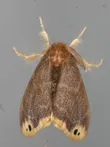Harmful Effects of Bean tussock moth
A species of Cifuna
Bean tussock moth poses risks to plant health through defoliation, hindering photosynthesis and potentially causing plant death. Transmission occurs as bean tussock moth chews on plant tissues. The severity of the impact varies, with extreme cases resulting in plant mortality.
What Type of Pest Is Bean tussock moth?









AI entomologist in your pocket
Scan QR code to download

